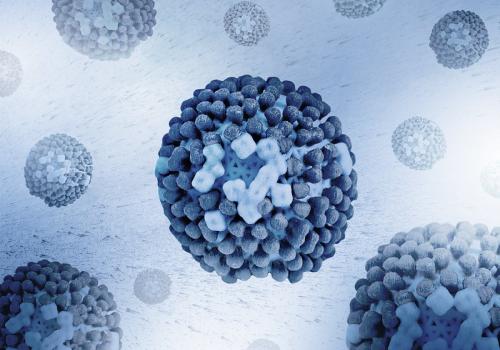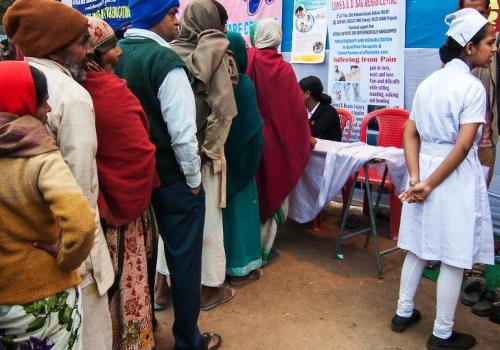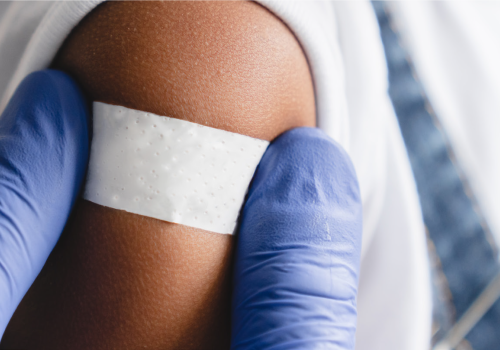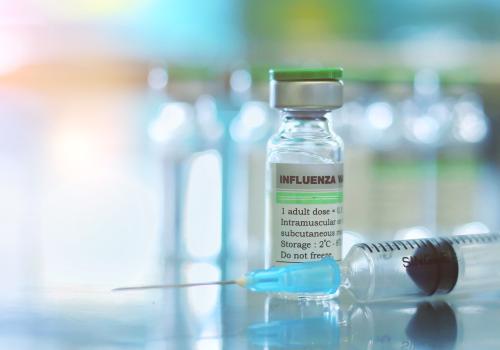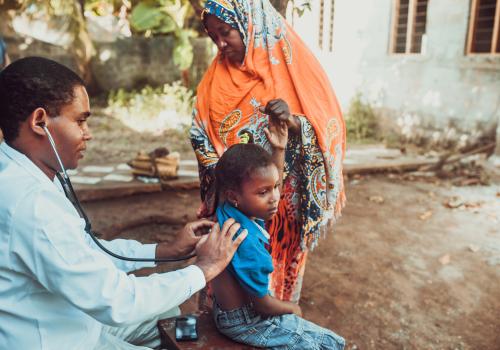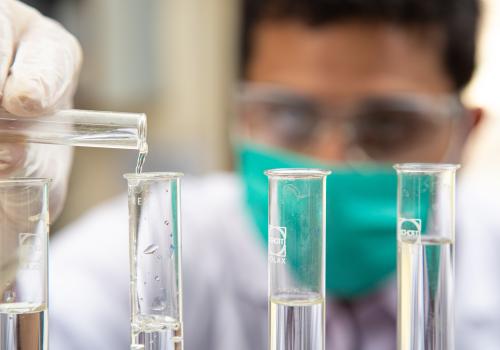Menu
- Introduction and Background
- Topic 1: Virology Applicable to Vaccine Development
- Topic 2: Immunology and Immune Correlates of Protection
- Topic 3: Vaccinology for Seasonal Influenza Vaccines
- Topic 4: Vaccinology for Broadly Protective or Universal Influenza Vaccines
- Topic 5: Animal Models and the Controlled Human Influenza Virus Infection Model
- Topic 6: Policy, Financing, and Regulation
- Acronyms
- Archive
Introduction and Background
The Center for Infectious Disease Research and Policy (CIDRAP) at the University of Minnesota, with support from Wellcome Trust, created the Influenza Vaccines Research and Development (R&D) Roadmap (IVR). The IVR serves as a strategic planning tool to facilitate R&D, coordinate funding, and promote stakeholder engagement in R&D aimed at improving seasonal influenza vaccines and generating broadly protective or universal influenza vaccines. The roadmap identifies critical issues and challenges for improving vaccines, prioritizes research activities, and identifies a set of realistic goals and aligned milestones across six topic areas: virology; immunology; vaccinology for seasonal influenza vaccines; vaccinology for broadly protective or universal influenza vaccines; animal models and the controlled human influenza virus infection model; and policy, financing, and regulation. Milestones focused on activities essential to advance influenza vaccine R&D are designated high priority. The IVR was launched online in September 2021.
In early 2022, CIDRAP initiated a 3-year IVR monitoring, evaluation, and adjustment (ME&A) program, with support from Wellcome Trust, to continuously track and summarize R&D progress toward the milestones across all topic areas. In the context of documented research progress, the roadmap’s strategic goals and aligned milestones were reviewed and updated, with extensive input from the IVR steering group, IVR taskforce, and other key experts.
The IVR ME&A project concluded in July 2025 with a fully revised and updated set of strategic goals and milestones, which are detailed in this document. The July 2025 roadmap includes all the final milestones, without specific notation related to milestones removed during the revision process. The original roadmap (September 2021), updated versions (February 2023, November 2024), and this final revised July 2025 version are available on the IVR initiative website.
The revised goals and milestones reflect the definitions of universal, broadly protective, and next generation influenza vaccines which were determined by taskforce consensus during IVR development, as noted in the original roadmap:
Universal influenza vaccine: Offers protection against all influenza A and B viruses, including seasonal viruses and existing or emergent zoonotic viruses with pandemic potential.
Broadly protective influenza vaccine: Offers protection against multiple influenza viruses but does not meet the criteria for a universal vaccine. For example, a broadly protective vaccine could confer protection against all strains within a single hemagglutinin (HA) subtype (subtype-specific), multiple HA subtypes within a single group (multi-subtype), all group 1 or group 2 influenza A viruses (pan group), or all influenza B viruses.
Next-generation influenza vaccine: Involves a different strategy than currently licensed seasonal vaccines to elicit protective immune responses against influenza viruses (e.g., uses different vaccine platforms or targets antigens other than, or in addition to, the variable HA head epitopes), demonstrating an improvement over current vaccines in durability, efficacy, or breadth of protection.
Summary of IVR Milestones by Topic and Strategic Goal
UPDATED JULY 2025
Strategic Goals and Aligned Milestones for Topic 1: Virology Applicable to Vaccine Development
| Strategic Goal 1.1: Improve understanding of human and animal influenza virus evolution. |
|---|
| Milestone 1.1.a (High Priority): Refine strategies to improve efficiencies in obtaining sequences and isolates of circulating influenza viruses in human populations and a broad range of animal species, including species not previously recognized as important for influenza, such as bovine. |
| Milestone 1.1.b: Convene a group of stakeholders to determine how best to use new tools, such as computational approaches, machine learning, and systems biology, to enhance understanding of influenza virus evolution and to improve capabilities to predict circulating influenza virus strains, including emergence of novel viruses. |
| Milestone 1.1.c: Integrate research to develop and implement a plan to improve genetic and antigenic characterization of emerging and circulating influenza viruses (including epitopes beyond HA and NA, such as T-cell epitopes), using techniques such as deep-sequencing technology, computational biology, and phylogenetic analysis. This plan should outline specific goals for how analytic characterization can be used to predict antigenic drift. Ongoing screening of emerging strains with a standardized, regularly updated panel of monoclonal antibodies (mAbs) binding key epitopes could also be considered as part of this effort. |
| Milestone 1.1.d (High Priority): Develop a comprehensive landscape of population-based serosurveillance studies in different age groups and geographic regions to better understand the relationship between population immunity to seasonal influenza viruses and antigenic drift, which is needed to determine how serosurveillance data can be used to improve decisions regarding vaccine strain selection for seasonal influenza vaccine production. |
| Strategic Goal 1.2: Enhance the ability to forecast viruses that are likely to circulate in the upcoming season to improve the antigenic match between circulating influenza viruses and viral strains selected for vaccine production. |
|---|
| Milestone 1.2.a: Determine how to use genetic sequence data and technologies for modeling and forecasting to improve the antigenic match between vaccine strains and circulating strains, and develop methods to improve forecasting of circulating viruses. |
| Milestone 1.2.b: Reconvene the World Health Organization (WHO) expert group on improving influenza vaccine virus selection to review activities for improving the antigenic match between circulating viruses and annual vaccine seed strains, as outlined in 2015 by the WHO; develop consensus on new strategies to improve forecasting; and update the 2015 consensus report as needed to reflect new developments and strategies. |
| Milestone 1.2.c (High Priority): Continue to develop, harmonize, and implement methods (e.g., the use of predictive artificial intelligence and other new technologies) to inform antigenic characterization of H1N1 and H3N2 viruses. |
| Strategic Goal 1.3: Improve the ability to detect and understand the emergence of novel influenza viruses with pandemic potential. |
|---|
| Milestone 1.3.a: Expand surveillance of influenza viruses at the human-animal interface, including in wild birds and in Africa, Asia, and South America, to identify geographic surveillance gaps, highlight the need for coordination among international groups, improve understanding of the emergence of novel and potentially pandemic viruses in animal reservoirs, and promote data sharing and integration across different surveillance systems. Social scientists should be involved in planning and implementing human-animal interface studies. |
| Milestone 1.3.b: Identify funding and implement the expanded surveillance plan detailed in Milestone 1.3.a (to be funded for at least 5 years). One option is to create a coordinated global network of centers with the capability to sample wild birds, domestic animals, and humans at the human-animal interface to test for influenza viruses. |
| Strategic Goal 1.4: Enhance understanding of factors associated with viral transmissibility. |
|---|
| Milestone 1.4.a (High Priority): Review optimal study designs for evaluating influenza transmission, including controlled human influenza virus infection model (CHIVIM) studies and household and school-based transmission studies. |
| Milestone 1.4.b: Conduct at least two comprehensive influenza virus transmission studies in animals (to include naive and infected or vaccinated animals). |
| Milestone 1.4.c: Conduct at least one modeling study to predict influenza virus transmission across geographic regions and within species (e.g., humans, wild birds, domestic animals, agricultural animals). |
Strategic Goals and Aligned Milestones for Topic 2: Immunology and Immune Correlates of Protection
| Strategic Goal 2.1: Promote the development and standardization of immunologic tools to inform the development of universal, broadly protective, and next-generation influenza vaccines. |
|---|
| Milestone 2.1.a: Develop a comprehensive list of clinical trials globally that are ongoing or planned (such as ongoing cohort studies) and develop and share guidance to support the collection, management, storage, and distribution of clinical samples (including samples from commercial entities) for immunologic research relevant to improved influenza vaccines. |
| Milestone 2.1.b: Develop standardized reference reagents and harmonized assay protocols for studying immunoglobulin responses to influenza infection and vaccination, such as qualified assays for detecting mucosal antibodies. |
| Milestone 2.1.c: Develop standardized and lower cost assays (e.g., simplified high-throughput testing) for measuring T-cell responses to vaccination or infection. |
| Strategic Goal 2.2: Gain better understanding of human immunology to inform influenza vaccine development through research focused on new tools and technologies. |
|---|
| Milestone 2.2.a: Convene periodic international workshops to identify advances in understanding immune responses to influenza infection and vaccination that can be applied to improving seasonal vaccines and to developing durable, broadly protective or universal vaccines; disseminate a summary report of key findings from each workshop. |
| Milestone 2.2.b (High Priority): Determine key mechanisms of durability of protective immunity following influenza virus infection, including the discovery of early biomarkers associated with durable immune responses. |
| Milestone 2.2.c: Identify distinctions between immune responses to influenza infection and vaccination in different age-groups and birth-year cohorts. |
| Milestone 2.2.d: Characterize human immune responses to influenza vaccines in diverse populations, according to a range of host factors, including age, sex, pregnancy, obesity, presence of coinfections or other comorbidities, concurrent use of immunotherapies, geographic region, and socioeconomic factors. |
| Strategic Goal 2.3: Improve understanding of aspects of the B-cell immune response to influenza infection and vaccination that are important for developing better vaccines and optimal strategies for vaccination, particularly in the context of partial preexisting immunity from continual exposure to influenza viruses. |
|---|
| Milestone 2.3.a: Determine the mechanisms underlying the production of durable, broadly protective B-cell immunity driven by long-lived plasma cells in the bone marrow. |
| Milestone 2.3.b: Identify the factors that determine immunodominance hierarchies of B-cell responses to surface glycoproteins and identify methods to target subdominant, functionally conserved antigenic sites. |
| Milestone 2.3.c: Define the B-cell repertoire following infection and vaccination to clarify differences between the responses to natural infection compared with vaccination, which are relevant to inform broadly protective vaccination strategies. |
| Strategic Goal 2.4: Determine the impact of prior influenza virus infection or vaccination on future immune responses to influenza viruses or vaccines. |
|---|
| Milestone 2.4.a: Establish ongoing longitudinal clinical studies to follow cohorts of different age groups in various geographic locations to enable characterization of immune responses to naturally occurring influenza infection and vaccination over time. |
| Milestone 2.4.b (High Priority): Determine through birth-year cohort or clinical studies how repeated influenza vaccinations affect immune responses to subsequent influenza vaccinations, including immune responses to HA, NA, and other antigens. |
| Milestone 2.4.c (High Priority): Determine how the initial encounter with an influenza virus or vaccine (i.e., immune imprinting) affects B- and T-cell responses, including immunologic responses to subsequent influenza virus infection and/or vaccination. |
| Strategic Goal 2.5: Clarify the role of T cells in generating or supporting protective immunity to influenza virus infection and/or vaccination. |
|---|
| Milestone 2.5.a: Identify major influenza epitopes recognized by CD4 and CD8 T cells for a comprehensive range of human leukocyte antigen (HLA) types and define the epitopes that elicit broadly protective T-cell immunity. |
| Milestone 2.5.b: Determine CD4 or CD8 T-cell effector functions that are most needed to enhance protective immunity or to modulate disease severity and determine whether T cells require localization in lymph nodes or mucosal tissue to be protective, and characterize the drivers and markers of T-cell homing to the respiratory mucosa. |
| Milestone 2.5.c: Define the role of heterologous infections (e.g., sequential infection with different influenza A virus strains) on the establishment and maintenance of CD4 and CD8 T cells. |
| Strategic Goal 2.6: Improve understanding of the role of mucosal immunity in protecting against influenza. |
|---|
| Milestone 2.6.a (High Priority): Characterize the role of mucosal immunity (including antibodies and T cells) in protecting against influenza virus infection, disease, and transmission. |
| Milestone 2.6.b: Clarify drivers of myeloid and lymphoid cell differentiation and migration to protect the upper and/or lower respiratory airway and determine how this information can be translated into vaccine R&D. |
| Milestone 2.6.c: Identify how the route of vaccination (e.g., intranasal, oral, sublingual, or other mucosal route) affects the magnitude of mucosal humoral and cellular immunity. |
| Strategic Goal 2.7: Develop novel correlates of protection for assessing seasonal influenza vaccines and broadly protective or universal influenza vaccines as part of clinical studies that demonstrate efficacy against a disease endpoint. |
|---|
| Milestone 2.7.a: Develop functional assays that are fit for clinical trial purpose to accurately capture the breadth and range of protective responses other than virus neutralization, such as influenza virus–specific antibody-dependent cellular cytotoxicity (ADCC), antibody-dependent cellular phagocytosis, and complement-dependent cytotoxicity. |
| Milestone 2.7.b (High Priority): Develop correlates of protection for mucosal immunity based on different vaccine platforms (e.g., live-attenuated influenza virus) and routes of administration (e.g., intranasal). |
| Milestone 2.7.c (High Priority): Conduct side-by-side standardized comparative studies of immune markers, beyond serum hemagglutination inhibition (HAI) titers, as potential correlates of protection in vaccine efficacy/effectiveness studies or in studies that use a controlled human influenza virus infection model. |
| Milestone 2.7.d (High Priority): Develop correlates of protection for influenza vaccine candidates based on antigens other than HA (e.g., NA, nucleoprotein [NP], HA stem), for vaccines produced using novel platforms (e.g., nanoparticles and nucleic acids), and relevant to a variety of endpoints (e.g., cellular immune responses, severe disease). |
Strategic Goals and Aligned Milestones for Topic 3: Vaccinology for Seasonal Influenza Vaccines
| Strategic Goal 3.1: Promote strategies that shorten the lag time from identification of candidate vaccine viruses through the process of annual vaccine production and release. |
|---|
| Milestone 3.1.a: Streamline the production of new potency assays to ensure timely release of annual vaccine preparations. |
| Milestone 3.1.b: Provide funding (such as through private-public partnerships) to further develop the most promising egg-independent vaccine production methods. |
| Milestone 3.1.c: Continue to conduct studies comparing efficacy, safety, and relative effectiveness of new egg-independent production methods to each other and to egg-based methods. |
| Strategic Goal 3.2: Identify strategies and policies to optimize seasonal influenza vaccines and improve vaccine benefit-risk profiles. |
|---|
| Milestone 3.2.a: Identify lessons learned from COVID-19 vaccine development that are applicable to improving seasonal influenza vaccines. Include a summary of the current landscape of next generation influenza vaccine candidates based on mRNA and other new platform technologies used in COVID-19 vaccines. |
| Milestone 3.2.b (High Priority): Review the development and safety of novel vaccine platforms to identify how best to apply them to develop improved seasonal influenza vaccines. |
| Milestone 3.2.c: Document that at least two combined COVID-19 and seasonal influenza vaccines are being evaluated in clinical trials. |
| Milestone 3.2.d: Determine the utility of further adjusting antigen doses in existing seasonal influenza vaccines for different populations and age-groups. |
| Milestone 3.2.e: Conduct clinical trials to assess combinations of licensed seasonal influenza vaccines and vaccine components (e.g., adjuvants) to identify strategies that offer improved effectiveness against influenza. |
| Milestone 3.2.f (High Priority): Evaluate the immunogenicity and efficacy of alternate routes of vaccine delivery (e.g., intranasal, oral, intradermal needle-free) to enhance mucosal immunity and/ or block transmission. |
| Strategic Goal 3.3: Further assess the role of existing and new adjuvants in creating next-generation seasonal influenza vaccines. |
|---|
| Milestone 3.3.a (High Priority): Determine, through clinical studies, if any promising adjuvant candidates under investigation can substantially improve vaccine efficacy in the elderly, and assess their safety profiles. |
| Milestone 3.3.b (High Priority): Determine, through clinical studies, if adjuvants substantially improve vaccine efficacy in the very young, and assess their safety profiles. |
| Strategic Goal 3.4: Determine the role of NA as a vaccine antigen for improving the effectiveness and immunogenicity of seasonal influenza vaccines. |
|---|
| Milestone 3.4.a: Generate standardized, harmonized, and validated assays for measuring NA content in seasonal influenza vaccines. |
| Milestone 3.4.b: Measure and compare the antigenic variation of NA in seasonal influenza vaccines. |
| Milestone 3.4.c: Investigate options for altering manufacturing processes to retain or add NA to inactivated or recombinant influenza vaccines, and establish methods to confirm, measure, and standardize NA content during development and manufacture. |
| Milestone 3.4.d (High Priority): Determine if the presence of NA improves new or next-generation seasonal influenza vaccines, and, if so, establish the optimal dose of NA that improves immunogenicity and effectiveness and maintains an acceptable safety profile. |
Strategic Goals and Aligned Milestones for Topic 4: Vaccinology for Broadly Protective or Universal Influenza Vaccines
| Strategic Goal 4.1: Identify the most promising broadly protective or universal influenza vaccine candidates that elicit durable protection against influenza viruses in preclinical studies, with a focus on targeting conserved regions of the virus. |
|---|
| Milestone 4.1.a: Develop a set of preferred product characteristics (PPCs) for broadly protective and universal influenza vaccines, in collaboration with the WHO’s efforts to revise its 2017 guidance on PPCs for next-generation influenza vaccines. |
| Milestone 4.1.b: Develop a summary analysis of influenza vaccine approaches for broadly protective or universal influenza vaccines and create a mechanism to update this summary at least annually. |
| Milestone 4.1.c (High Priority): Continue research on new antigen design to enable the development of broadly protective or universal influenza vaccines. |
| Milestone 4.1.d (High Priority): Convene a workshop to review the scientific challenges and recent advancements in development of novel vaccine platforms to determine how best to guide R&D for broadly protective influenza vaccines for regulatory approval, global scale-up, and rapid deployment in response to pandemic influenza viruses. |
| Milestone 4.1.e (High Priority): Define selection criteria (e.g., including immunogenicity data from pre-immune animal models and considerations for global manufacturing capacity) for advancing preclinical influenza vaccine candidates into clinical evaluation. |
| Strategic Goal 4.2: Evaluate the most promising broadly protective or universal influenza vaccine candidates, using at least several different platforms, in clinical trials. |
|---|
| Milestone 4.2.a: Develop use cases for broadly protective vaccines, including, for example, pan-H5 vaccines for pandemic response, to define how, where, and under what circumstances such vaccines would be used. |
| Milestone 4.2.b (High Priority): Define and prioritize clinical endpoints for evaluating the efficacy of broadly protective influenza vaccines (e.g., prevention of laboratory-confirmed influenza, severe complications of influenza, hospitalization, death) to compare outcomes across studies. |
| Milestone 4.2.c (High Priority): Identify an initial set of vaccine candidates that demonstrate broad based immunity—humoral, cell-mediated, or both—in preclinical research and assess them for safety and immunogenicity in phase 1 clinical trials in healthy adults. |
| Milestone 4.2.d (High Priority): Determine biomarkers correlated with immune protection for different vaccine platforms. |
| Milestone 4.2.e (High Priority): Continue to analyze outcomes from broadly protective vaccine candidates in phase 1 trials and advance promising candidates into phase 2 and phase 3 clinical trials, including in high-risk populations. |
| Milestone 4.2.f (High Priority): Identify the most promising vaccine candidates from phase 2 trials and facilitate good manufacturing practice (GMP) and evaluation in phase 3 trials, such as through sponsorship in public-private partnerships. |
Strategic Goals and Aligned Milestones for Topic 5: Animal Models and the Controlled Human Influenza Virus Infection Model
| Strategic Goal 5.1: Optimize animal models for influenza vaccine research. |
|---|
| Milestone 5.1.a: Sustain mechanisms for broad sharing of animal model resources (e.g., standardized and validated viruses, protocols, reagents, and tissue samples) that can be used among a wide range of investigators as standards for influenza vaccine research, which is particularly important given constraints on the availability of experimental animals. |
| Milestone 5.1.b (High Priority): Sustain funding for validated reagents, updated viral stocks, and harmonized assays, which are needed to evaluate innate and adaptive immune responses in ferrets and other animals such as hamsters and to facilitate comparison of studies across laboratories. |
| Milestone 5.1.c: Harmonize best practices for conducting influenza virus transmission studies in animals such as hamsters and guinea pigs, as was done in ferrets, to include naive and infected or vaccinated animals. |
| Milestone 5.1.d: Continue development of pre-exposure animal models to address the fact that humans generally have pre-existing immunity to influenza. |
| Milestone 5.1.e (High Priority): Develop comparative vaccine studies using the high-risk ferret model to inform predictions of vaccine responses in high-risk human populations. |
| Milestone 5.1.f (High Priority): Review a comprehensive analysis of the predictive value of different animal models, including natural hosts such as pigs and horses, for influenza vaccine studies (for both seasonal and broadly protective vaccines). |
| Milestone 5.1.g (High Priority): Develop and validate animal models for evaluating immune responses—including durability and mucosal immunity—to broadly protective influenza vaccines. |
| Milestone 5.1.h: Characterize the major histocompatibility complex (MHC) epitopes in the ferret model to better allow assessment of T cell–based vaccines. |
| Strategic Goal 5.2: Address steps needed to further develop and refine the CHIVIM. |
|---|
| Milestone 5.2.a (High Priority): Generate guidance, including ethical and safety considerations, for using the CHIVIM. |
| Milestone 5.2.b (High Priority): Ensure the broad availability to investigators of a biorepository of diverse, well-characterized challenge viruses, cell lines, and human samples for manufacture and CHIVIM studies. |
| Milestone 5.2.c: Share data, information, and protocols across multiple centers conducting CHIVIM studies to maximize benefit. |
Strategic Goals and Aligned Milestones for Topic 6: Policy, Financing, and Regulation
| Strategic Goal 6.1: Catalyze broad support and sustained funding for developing improved seasonal influenza vaccines and broadly protective or universal influenza vaccines. |
|---|
| Milestone 6.1.a (High Priority): Develop and disseminate a full value of vaccine assessment (FVVA; also referred to as the full value of influenza vaccine assessment [FVIVA]) for improved seasonal and broadly protective, universal influenza vaccines that addresses different vaccine use cases and includes an assessment for low- and middle-income countries (LMICs). |
| Milestone 6.1.b (High Priority): Develop targeted and creative communications and advocacy strategies and necessary communication tools that build on the FVIVA and provide information on economic costs, the risk of future influenza pandemics, and the need for investment in influenza vaccine R&D. |
| Milestone 6.1.c: Create, implement, and maintain a mechanism to track influenza vaccine R&D funding trends to better assess where funding is being allocated and identify gaps in funding for priority research. |
| Milestone 6.1.d: Determine the feasibility of establishing a new public-private partnership, with robust funding, to identify and implement creative approaches to de-risk and accelerate development of universal, broadly protective, and next-generation influenza vaccines for pandemic preparedness and seasonal influenza. |
| Strategic Goal 6.2: Promote innovation for developing improved seasonal influenza vaccines and broadly protective or universal influenza vaccines. |
|---|
| Milestone 6.2.a (High Priority): Distill lessons learned for influenza vaccines from experience with COVID-19 vaccine R&D, including clinical research and study designs, manufacturing, distribution, advocacy, financing, and global collaboration. |
| Milestone 6.2.b: Maintain engagement with industry partners to regularly examine market challenges and evaluate potential solutions, including market incentives to help de-risk vaccine R&D and develop a market share for producing improved influenza vaccines. |
| Milestone 6.2.c: Similar to the “evidence to recommendation” framework created by the WHO Strategic Advisory Group of Experts on Immunizations Working Group on COVID-19 vaccines, create a framework that identifies the critical evidence needed to inform (1) the design of clinical trials for universal or broadly protective influenza vaccines and (2) policy recommendations for the use of universal or broadly protective influenza vaccines once they are approved. |
| Milestone 6.2.d: Develop an influenza prevention and control roadmap to advance the WHO Global Influenza Strategy that addresses health equity issues, encompasses the interests of LMICs— including the need for improved seasonal influenza vaccines—and is aimed at supporting country transitions from annual vaccination programs to the use of more durable, broadly protective or universal vaccines. |
| Strategic Goal 6.3: Promote information sharing aimed at moving influenza vaccine development forward. |
|---|
| Milestone 6.3.a: Create and maintain a comprehensive landscape of universal influenza vaccine technologies in preclinical and clinical development and develop a mechanism to update and analyze the landscape, including identifying key factors underlying successful R&D efforts as well as persistent challenges and obstacles. |
| Milestone 6.3.b (High Priority): Assess and document the ongoing impact of the Nagoya Protocol and possibly related national access and benefit sharing (ABS) legislation, on sharing of influenza isolates and gene sequences in relation to influenza vaccine R&D; share findings with key policymakers (e.g., ministries of health/agriculture and global trade); and determine strategies to address potential unintended consequences. |
| Milestone 6.3.c: Implement a plan that improves existing data management and sharing among influenza R&D researchers that includes developing an approach for reusing influenza vaccine study data (e.g., secondary mining of datasets). |
| Milestone 6.3.d: Conduct mapping of intellectual property for improved influenza vaccines to identify synergies in approaches that may be used to develop new partnerships. |
| Milestone 6.3.e: Taking into consideration ongoing global negotiations related to intellectual property (e.g., the Pandemic Agreement), develop a consensus vision for sharing intellectual property or proprietary technologies related to improved influenza vaccines that includes benefit sharing and equitable access for LMICs. |
| Milestone 6.3.f: Identify a party to convene a group of key R&D stakeholders tasked with developing and establishing a set of harmonized data standards and explore mechanisms for broader data sharing. |
| Strategic Goal 6.4: Address regulatory challenges in the evaluation and licensure of next-generation, broadly protective, and universal influenza vaccines. |
|---|
| Milestone 6.4.a (High Priority): Convene a workshop to address regulatory science issues regarding the evaluation of next-generation and broadly protective influenza vaccines for pandemic preparedness and seasonal influenza vaccination and publish a consensus summary report. |
| Milestone 6.4.b: Identify a framework to address post-marketing assessment of safety and relative effectiveness of broadly protective or universal influenza vaccines compared with conventional seasonal influenza vaccines. |
| Milestone 6.4.c: Develop consensus on best practices for using CHIVIM studies to support licensure of universal or broadly protective influenza vaccines. |
| Milestone 6.4.d: Develop consensus definitions on clinical endpoints for severe influenza disease in vaccine efficacy studies. |
| Milestone 6.4.e: Develop and validate a standard scale for assessing influenza disease severity in clinical studies. |
| Milestone 6.4.f: Develop and validate correlates of protection for severe influenza disease as a surrogate endpoint in clinical studies. |
| Milestone 6.4.g: Develop a consensus approach on clinical methodologies for demonstrating vaccine effectiveness in preventing severe influenza disease in different geographical settings. |
ABS Access and benefit sharing
ADCC Antibody-dependent cellular cytotoxicity
CHIVIM Controlled human influenza virus infection model
CIDRAP Center for Infectious Disease Research and Policy (University of Minnesota)
CIVICs Collaborative Influenza Vaccine Innovation Centers (NIH)
FVIVA Full value of influenza vaccine assessment
FVVA Full value of vaccine assessment
GMP Good manufacturing practice
HA Hemagglutinin
HAI Hemagglutination inhibition
HLA Human leukocyte antigen
IVR Influenza Vaccines Research & Development Roadmap
LMIC Low- and middle-income countries
mAb Monoclonal antibody
ME&A Monitoring, evaluation, and adjustment
MHC Major histocompatibility complex
mRNA Messenger ribonucleic acid
NA Neuraminidase
NP Nucleoprotein
PPC Preferred product characteristics
R&D Research and development
WHO World Health Organization
All published versions of the Influenza Vaccines R&D Roadmap will be maintained here for reference.
